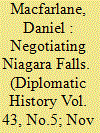|
|
|
Sort Order |
|
|
|
Items / Page
|
|
|
|
|
|
|
| Srl | Item |
| 1 |
ID:
115092


|
|
|
|
|
| Publication |
2012.
|
| Summary/Abstract |
The mufti recounted with fondness a drive he made with his wife from Montreal via Toronto to New York in 1994. Somewhere past Niagara Falls, the couple stopped at a McDonald's. All the seats were taken. "I was dressed like this," the mufti said, pulling at the lapel of his robes, "and my wife was in hijab." An American man, aged about sixty-five, got up and offered them his table. When the mufti declined, the man insisted, "I'm an American, and I can go home and eat. You are my guest."
|
|
|
|
|
|
|
|
|
|
|
|
|
|
|
|
| 2 |
ID:
169505


|
|
|
|
|
| Summary/Abstract |
Niagara Falls is one of the world’s most iconic natural features. Yet in many ways Niagara Falls is decidedly unnatural, for the United States and Canada physically manipulated this waterfall over the course of the twentieth century so that its waters could be diverted for hydropower production while still ostensibly retaining the cataract’s aesthetic beauty for tourism. While this appears contradictory, since the latter depends on ample amounts of water flowing over the Falls while the former requires water going around the Falls, experts believed that they could engineer a compromise and essentially fool the public. Following the 1950 Niagara River Diversion Treaty, the two North American nations constructed hydroelectric stations and remedial works (various engineering interventions including excavations, fills, reclamations, weirs, and dams) at Niagara Falls that allowed for the majority of the water volume to be diverted for power production. Moreover, the largest of the Niagara cataracts, the spectacular Horseshoe Falls, was reshaped in an effort to hide the fact that the majority of the Niagara River’s water volume was abstracted.
|
|
|
|
|
|
|
|
|
|
|
|
|
|
|
|
| 3 |
ID:
128023


|
|
|
|
|
| Publication |
2014.
|
| Summary/Abstract |
Niagara Falls and the Niagara River have always attracted great public interest due to their natural beauty, their enormous potential for electricity generation, their recreational value and as an important ecosystem. There have been simultaneous efforts to preserve this unique natural wonder and harness its power through hydroelectric development projects by both the United States and Canada. This paper explores the evolution of these efforts that culminated with the signing of the 1950 Niagara River Water Diversion Treaty that established minimum water flow rates to protect the "scenic beauty" of the falls, allowing the remaining water to be diverted for power production. We examine the rationale that led to specific water flow restrictions and question to what extent they are relevant today, as water intake capacity on the Canadian side has just been extended by around 25%. We find that current restrictions under the Niagara River Water Treaty (that expired in 2000) are not based on sound scientific evidence and estimate the upper limit of potential foregone benefits from clean electricity generation and greenhouse gas reductions. We identify a number of important issues that emerged in the last decades and that would justify an exploration of new treaty rules.
|
|
|
|
|
|
|
|
|
|
|
|
|
|
|
|
|
|
|
|
|